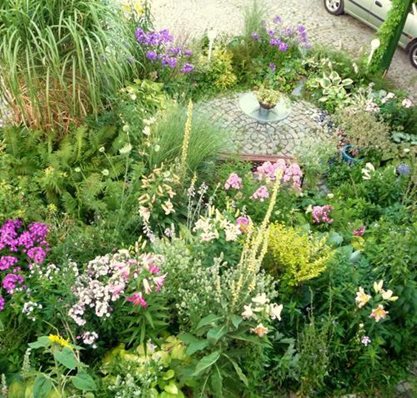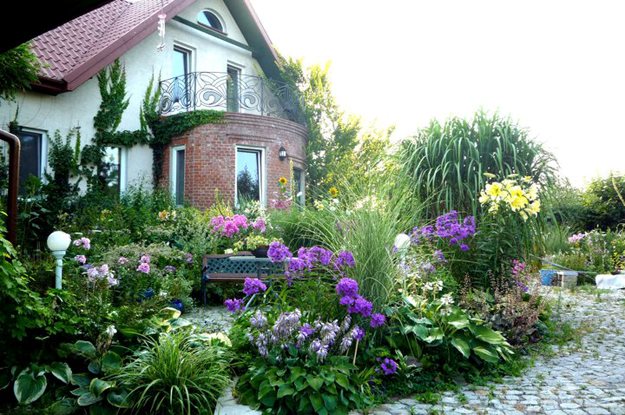My Garden: Against All Odds
In the face of droughts, flooding, poor soils and harsh winters, this verdant garden in central Poland still thrives thanks to a determined gardener named Joanna. Boasting hundreds of varieties of plants, this small but hearty garden shows even when the odds aren’t particularly in your favor, a little experimenting and resilience goes a long way.Joanna Nowacka-Zaborska has several Facebook photo albums full of images of her lush 1-acre garden in central Poland, near the Vistula river basin. She’s very proud of this labor of love, and enjoys sharing the beauty she has created with others. Joanna and her husband bought the property, located on a former strawberry field, about 15 years ago. She started out with a barren lot, little gardening experience, and a location beset by sandy soils and challenging climate conditions. Driven by her passion and never-give-up attitude, she single-handedly transformed the grounds into a paradise of blooms.

After planting a few varieties of Phlox paniculata, Joanna started to produce her own cross seedlings and now has many different shadows of phloxes in a shady border in the garden.
“I have planted thousands of plants, year by year. I dig every hole, I plant every flower, and do the weeding alone, because only I know where to plant and what plant to pick,” she says.
Although Joanna has studied horticulture, much of her gardening knowledge and artistic eye came from visiting gardens in England and reading countless books on the subject. From there, her experimental nature and addiction to finding new plant varieties took over. “I have bought every variety and species of ornamental plant that I could find in the nurseries in Poland. I also love to observe the seedlings in my garden. After planting a few varieties of Phlox paniculata, I started to produce my own cross seedlings, so now you can see many different shadows of the phloxes in a shady border in my garden,” she says.

Joanna Nowacka-Zaborska’s biggest challenge in her garden is Mother Nature with freezing temperatures in the winter and lots of snow, spring frosts, and then too much summer rainfall (or complete lack of it).
As is true for many gardeners, the biggest challenge for Joanna has been Mother Nature. “In the winter, we typically have a lot of snow, and -20 degrees Celsius temperatures. But sometimes it drops below -40 degrees Celsius without snow cover, and then the ground freezes to a depth of 1 meter (more than 3 feet). Many plant species die easily in such conditions. I lose many ornamental bulbs every few years and lots of perennials. During spring, we often have frost around the middle of May, which kills many plants as well,” she laments.
During the summer, her challenge is often too much rainfall—or the complete lack of it. “Some years, we have moderate summer temperatures with sufficient rainfall. But other years are awfully hot with terrible droughts lasting many weeks,” she says. Because her garden lies in a former riverbed of the Vistula, it is also prone to flooding if it rains incessantly. “I will sometimes lose entire plant collections if the level of water rises too high.”
Because of these unpredictable conditions, she favors plants that can survive the worst. “I have tested absolutely everything that one could buy in Polish nurseries. I have learned what plants are tough and will stay strong and healthy. I am crazy about hostas (I have over 100 varieties) and ornamental grasses, which just recently became ‘fashionable’ in Poland. I love echinaceas, especially the newer varieties in every shade of pink, red, and yellow. They survive frost and very dry conditions,” she says.
To see more photos of Joanna’s garden, visit her Facebook page.

Over 100 varieties of hostas, plus ornamental grasses and echinaceas were selected for this lush 1-acre garden in Poland because of their toughness and ability to survive frost and very dry conditions.
Joanna’s Gardening Lessons
- Reuse your lawn clippings. “I have no chance with weeds, but I got much better control of the situation when I started to use mulch from mowing lawns to cover the surface of the soil along borders.”
- Don’t plant impulsively. For many years, I got one specimen of each plant variety, so it looked like a crazy collection with too many different shapes and sizes. To put it in some kind of order, I decided where I would group plants by bloom color and height. I planted trees in the back, shrubs in the middle, and the smallest plants in the front of the border. This worked for many years, but when I lose older and bigger plants and replace them with new ones, everything is upside down for a while.

